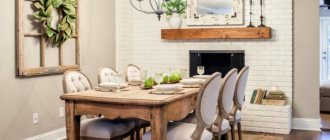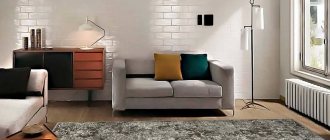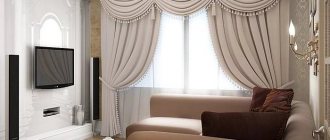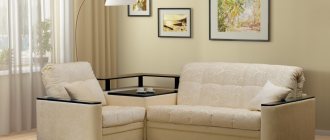The living room is the calling card of any home. This is where we welcome guests and spend evenings with family. Therefore, it is important to provide this room with comfort and warmth. And what could be more comfortable than a soft and pleasant carpet under your feet? With it, any living room becomes lived-in and harmonious. However, it is difficult to decide on the variety of carpet options, their designs, colors, materials and sizes. We will help you figure out which rug is best to put on the living room floor.
How to choose a carpet for the floor based on composition
Based on their composition, all carpets can be divided into three large groups. The first two are obvious - natural and synthetic. There are also mixed ones, and the “mixtures” themselves are very different in composition. Some are predominantly natural fibers, others are more synthetic. The choice of material for a carpet in the living room should be made with an eye to the mode in which it will be used. If the living room is just a formal room, the main criteria are aesthetics and cost. Are you used to relaxing in the living room/hall, is your child playing there? More attention should be paid to the practical side - how easy it is to care for and clean.
If you are offered a hundred options, choosing a carpet is not at all easy. And if there are a couple hundred offers...
Price policy
Natural ones - no matter what fiber they are made from, cost much more than synthetic ones. And this is one of the disadvantages of this group. If you do not want to spend significant amounts of money on a purchase, immediately look at synthetics. In terms of their characteristics, synthetic floor carpets are at least as good as natural ones. But much cheaper.
Prices for carpets have a very wide range - from several thousand to hundreds of thousands.
The second disadvantage of natural carpets is from the field of use. It is more difficult to care for products made from natural fibers; not everything can be washed. They can often be dry cleaned, but this treatment costs accordingly. But “natural” is prestigious and expensive. But, for example, only specialists can distinguish between a woolen and an acrylic carpet. So “expensive” often remains only in the mind of the owner. There are other disadvantages, but they vary and depend on the material.
Types of natural carpets, their pros and cons
Everyone makes the clear choice (whether you want natural or synthetic fibers in the carpet) yourself. Everyone has their own selection criteria. But you need to know all the pros and cons of the possible options. So, the advantages and disadvantages of the most common natural fibers for carpets. The carpet in the living room can be from:
- Wool. Wool can be sheep; camel wool is much less common on our market, but you can also find it. Sheep wool can be from regular sheep or merino sheep. In any case, a wool floor carpet is expensive. Merino wool is even more expensive. The main argument for it is that wool is warm. And indeed it is. But there are also a lot of disadvantages. The main one is that it can cause allergies. And although carpets made from merino wool are said to not cause allergies, this is not a guarantee. There have been cases when there were reactions to merino wool. If there is a tendency to such a disease in the family, any wool is contraindicated. Another feature is that you cannot get wool of a bright shade, that is, the tones will be muted. If this option suits you, great. If you need bright colors, look towards synthetics, or viscose/silk/cotton.
Wool carpets are warm, but very expensive. Silk coverings look chic, but also cost as much as an airplane wing - Silk carpets. Beautiful, elegant, with a slight shine. But thin and protection from the cold can only be relative. But they do not cause allergies and are compact when folded, making them easy to transport. They take special care - they can fade and become deformed when washed.
- Jute. Jute fiber has a distinctive appearance, so all jute carpets are recognizable. They do not fit into all styles. They have a low price and do not cause allergies. They are easy to care for, but don’t expect complex patterns. Regular matting in brown, beige, gray colors is the most common option. They are found with some kind of weaving, but the price is much higher. If you want colored carpets or rugs, you can find a jute rug that is dyed or bleached, but you won't find “pure” colors. It is impossible to bleach jute until it is snow-white, which is why the colors are mixed with brown or gray. And the structure of the fiber is such that a “pure” color is simply impossible. In general, a jute carpet in the living room in some styles is an irreplaceable thing.
A jute carpet fits perfectly into some ethnic interiors: rustic, modern, some trends of modern style, which are distinguished by laconicism and comfort. - Cotton carpets for the living room. If you definitely want something natural, but inexpensive, pay attention to this material. Cotton dyes well and does not cause allergies. The cost is cheaper than wool and, especially, silk. It absorbs moisture well, but there is no guarantee that after drying it will have the same shape. So not all cotton rugs can even be wetted. But after washing they can be ironed. True, this takes a lot of time and is not an easy task. But the result is a much better view.
Common disadvantages of all natural carpets include problematic maintenance and high cost. Carpets are now replaced with every renovation or even when changing textiles. It's hardly worth investing a lot of money. And the service life of 50 years (for wool and silk high-quality carpets) is no longer in demand. Therefore, synthetic fibers are increasingly being chosen. By the way, there are more offers in shapes, colors, textures in this category. There is plenty to choose from.
Living room carpet made of synthetic fibers: advantages and disadvantages
The word "synthetic" was synonymous with the phrase "poor quality" some time ago. Currently the picture is completely different. Modern synthetic threads have excellent characteristics. They have the advantages of natural fibers, but do not have their disadvantages. The main advantage is lower cost. They also dye well, so the color can be vibrant. They are also easy to care for, weigh (usually) a little, and are rolled into small rolls, which makes them easier to transport.
Modern carpets for the living room for lovers of non-standard solutions
Here are the types of fibers a synthetic carpet can be made of:
- Viscose. This is relatively synthetic, since the threads are made from cellulose. But the process is long and complex, so viscose carpets are often classified as artificial. Viscose dyes well and can have a slight sheen, almost like silk. Its properties are similar to cotton - it absorbs moisture well. Many viscose carpets become deformed when wet, but the resulting lumps can be smoothed out. True, this is not easy to do. It is much easier if you have a steam generator/steamer. If you don't want to bother with ironing, dry cleaning is required periodically. So, the advantages of viscose floor carpets include hypoallergenicity, relatively low price, bright colors, and consistency of shape.
Synthetic carpets are available in any design. Their low price and normal performance properties determined their popularity. - Acrylic fiber. Acrylic has properties similar to wool, but does not cause allergies. Can be washed without problems (at a car wash too). The material is durable, with good fiber quality it does not fade or fade. The disadvantage is the ability to accumulate static electricity. So when cleaning, add antistatic substances - dust will accumulate less, and it will be easier to clean the coating.
Unnatural carpets do not mean bad. They have a lot of advantages - Nylon carpets. Nylon is abrasion-resistant and holds its shape well, but over time the pile gets crushed. To restore the pile, it is enough to treat it with steam. This treatment is carried out once every year and a half, after which it looks like new. For the production of carpets and rugs, two types of nylon are used: 6 and 6.6. The difference is in technology, there are no differences in use. So you don’t have to pay attention to the type of nylon. Nylon carpet is practical, but requires steaming to raise the pile.
In general, synthetic carpet for the floor is a justifiable choice. There are no particular disadvantages, only those inherent in one or another type of fiber. The price is low, so you can change it often if necessary.
Cleaning
YES: Be sure to check the carpet's care instructions before purchasing. There are inexpensive carpets, but they may not hold up well to cleaning. In some cases, natural carpets made of jute and cotton will have to be replaced with a new one - they will not tolerate spilled dyeing liquids. Otherwise, in most cases, care procedures are standard:
- vacuum 2 times a week and more often in high traffic areas;
- Try to wash the carpet once every six months. The old way is to take the product out into the snow and walk it with a beater. Another option is to clean with carpet shampoo or baking soda (a glass in a bucket).
Types of carpet pile
There are woven carpets - Turkish, for example, or the same jute ones, which are woven from threads on a large loom. But most of it has lint. There is carpet pile in the form of a closed loop, and there is cut pile. They give a different surface and a different appearance. Moreover, the properties also change. Some types of carpets are easier to clean due to the shape of the lint. So, this is the shape of the pile a carpet can be for a living room/hall, bedroom or children's room.
- Shaggy. “Weed” is popular now. “Shaggy” carpets made of thin or medium-thick threads (not loops). The pile can be of medium or long length - from 3 to 7 cm, but you can also find longer haired ones with shorter pile. The threads can be the same color or collected in similar shades; variegated ones are a little less common. They look modern and feel pleasant when walking barefoot. There are some difficulties with cleaning - it’s hard to vacuum, but you can adapt.
- Velor. Threads cut at the same level, closely spaced one to the other. After cutting, the threads are fluffed up. The result is a dense, smooth surface, sometimes with a slight shine, reminiscent of velor. The length of the thread can be short (2-3 mm), medium or long. You have to be careful with long-pile ones: they wrinkle and are difficult to vacuum due to their high density.
When choosing a carpet, pay attention to the type of pile. Its practicality and difficulty in cleaning depend on this - Friese. Heat-treated, highly twisted threads of medium to long length. Due to the fact that the threads are strongly twisted, they do not wrinkle. This type can be used in living rooms/halls as it does not wrinkle and is easy to clean.
- Saxony. A type of frisée. Loops are woven from tightly twisted threads. Then the tops of the loops are cut off and the threads are twisted together. The result is a long and medium pile that is elastic to creasing. The surface is textured (uneven). If you want a deep pile rug, consider Saxony. It will keep its original shape for a long time.
- Berber. Loops made of threads of different or the same level. The thread is thick, twisted, the loops are tightly fitted to each other. Usually made with short pile - a few millimeters. The result is a “rough” surface that can withstand loads well. This type of carpet is relatively inexpensive and practical. Due to the “closed” loops of twisted threads, dirt remains on the surface and is easily removed. The traditional coloring is a light base interspersed with darker shades, but as popularity has grown, other colors have begun to be made.
You also need to choose a carpet for the living room floor based on the type of pile - Scroll. Threads closely spaced to each other create a dense surface. They are cut to different heights, resulting in a relief pattern. Such carpets are also called sculptural or structural. They look gorgeous, but there are difficulties with care. If you have a “front” living room/hall, this option is for you. If the load on the carpet is higher than average, it will quickly lose its attractiveness.
So, if you need a practical carpet for the living room, frise, Saxony or Berber are best. Of these, the first two can be with medium or long pile. For families with children, it is better to consider Berbere or Frisée. But the choice is, of course, yours.
Selecting the size of carpets for the floor
The division of carpets by size is quite arbitrary, but it still exists. Floor carpets are divided into three categories:
- Large ones - with an area of more than 6 square meters.
- Medium - from three to six squares.
- Small - three square meters or less.
The size of the carpet for the living room must be chosen so that it looks harmonious.
Large carpets greatly attract attention. Therefore, their choice should be treated very carefully. In any case, the coating should not occupy the space from wall to wall. Then it’s better to choose carpet. The carpet is different in that part of the floor remains open. At a minimum, there should be at least 30 cm to the wall, but optimally 60 cm or more. In general, if the carpet occupies a larger area, the room looks more spacious. This trick is used in small rooms.
A medium-sized rectangular rug is the most popular if you need to make a cozy seating area
Medium carpets on the floor are the best choice in most cases when you need to create coziness and zone the space. Often medium-sized carpets are placed near sofas. Then in length it should be about 80-120 cm wider than your sofa. And the width can be half the length or more. Small rugs are also good for zoning, but they are rarely used for the living room. Still, this room is usually quite large. And small rugs are difficult to choose so that they do not “shallow” the space, are comfortable and at the same time fit into the interior.
The best carpet manufacturers - which company to choose
A high-quality carpet from a well-known brand can serve faithfully for decades without losing its visual appeal. Some companies even provide a guarantee on their products (up to 50 years). Unfortunately, many people still continue to buy low-quality rugs and carpets of dubious origin because of their cheapness.
With this approach, you can save money only here and now, and after 3-5 years you have to take the budget rug to the garage for indefinite storage and buy another product - a more decent one.
You can purchase coverage once and for life if you choose a truly durable product from a reputable manufacturer:
- Wool&Silk;
- Longbarn Company;
- MID;
- Luzern;
- Radici Pietro.
The products of these companies deservedly take first place in our ranking of the best. And yet, it is not the manufacturer’s name that will warm your feet in winter and decorate the interior, so when buying a carpet for your apartment, you will have to take into account a number of other criteria.
Recommendations: 12 best laminate collections
12 best linoleum collections
12 Best Cork Floors
How to choose the color of the carpet
You should choose the color of the carpet based not only on practicality. This is a significant component of the interior, and, first of all, we pay attention to how it fits into the decor. There are several basic points that will help you make your choice.
- If the interior turns out to be too calm and monotonous, you can dilute it by laying a bright carpet. In this case, you will need a few more small decorative elements - a pillow, a vase, a painting, etc.
Bright carpets on the floor attract attention. But they need to be correctly integrated into the interior. - If the atmosphere should be calm, we choose neutral tones from those that are already in the interior, and in considerable quantities. It is not always possible to match the same shade, but it should be as close as possible to the existing ones. Or something will have to be repainted/replaced.
The mood of a neutral interior can be quickly changed by just replacing the carpet and adding a couple of details of the same or similar color - When the living room is furnished with furniture of different colors, it is better to take a carpet of a neutral color - gray, beige. In this case, the color of the coating may overlap with the textiles, or you can match the color of one of the elements. But coverings with an inconspicuous pattern or without it at all look best when used with different furniture.
A light, neutral-colored rug is ideal to create a calm atmosphere. - If the floor is light, there are no restrictions on the choice of carpet color. But light-colored coatings look better on dark floors. Whether with a pattern or not, you have to look at the style.
The most fashionable carpets have soft colors.
The colors are blurred, others are visible . In general, the latest trend is faded patterns and colors. The most fashionable rugs look something like brushed wood surfaces. The paint is washed out and very thinned out. If there are patterns, they are geometric. Options with floral or plant patterns are used in rooms decorated in classical styles.
Accommodation
YES: Lay down carpet in high-traffic areas so that it covers the entire path. When walking on it, your feet should be completely on the surface. You cannot allow a situation where one foot steps on the carpet and the other walks on the bare floor.
YES: consider the installation method and evaluate whether it is possible to install one of them in your apartment. This:
- with glue or adhesive tape if the carpet is large and there is no furniture in the room yet;
- tension, better suited for stairs and mounted on special spikes.
It is worth noting that a rug, unlike a carpet, can only be laid on the floor.
Photo of modern carpets in the living room interior
No matter how much you tell us how to choose the size and color of a carpet for the living room, it’s still better to see it. More informative. Several diverse, but modern options for inspiration and understanding that carpets are not crap and last century. This is a very stylish interior decoration.
A bright carpet imposes significant restrictions. In order not to overload the interior with colors, the rest of the furnishings are either completely neutral or repeat the motifs and colors of the coating
A carpet with a pattern, even a simple and laconic one, is more difficult to fit correctly into the interior
Two thin carpets are warmer than one thick one
The currently popular grass carpets are very cozy, but choosing them is not easy
Lint-free carpets are also good. They are laconic, easy to care for and cost less than their “shaggy” counterparts made of the same material (due to lower thread consumption)
If you don't want to draw attention to the floor, the best choice is a neutral carpet with a short pile or no pile at all.
Comfort and harmony - that’s what brown color brings to the interior. And a carpet with long velor pile also promises a great rest
Arranging the carpet correctly in the living room is also a science. Usually they separate the recreation area - a sofa and armchairs, couches, banquettes
For traditional styles there are traditional solutions
Fashionable rugs may not be to everyone's taste, but there's something about it











